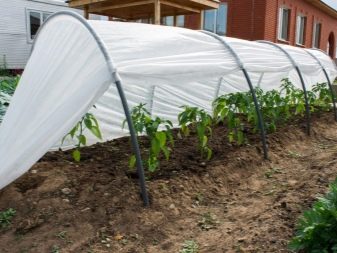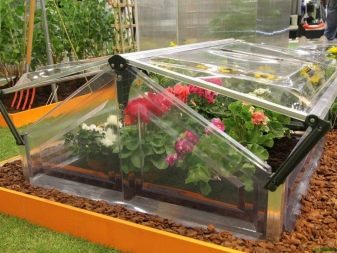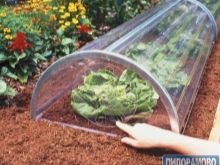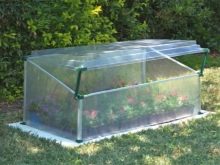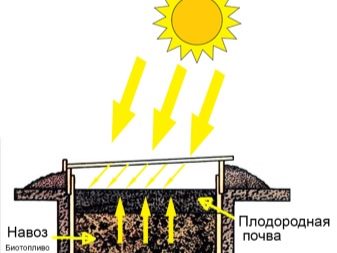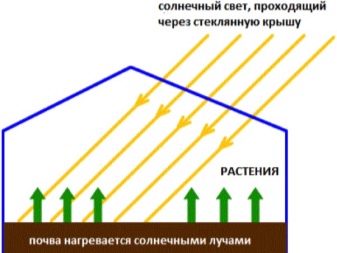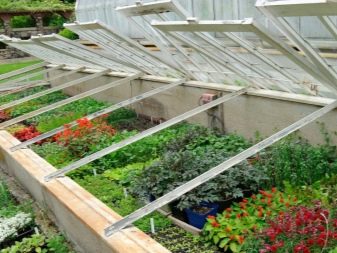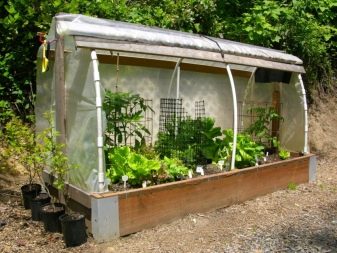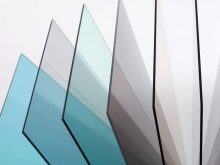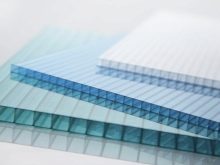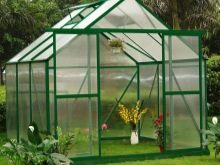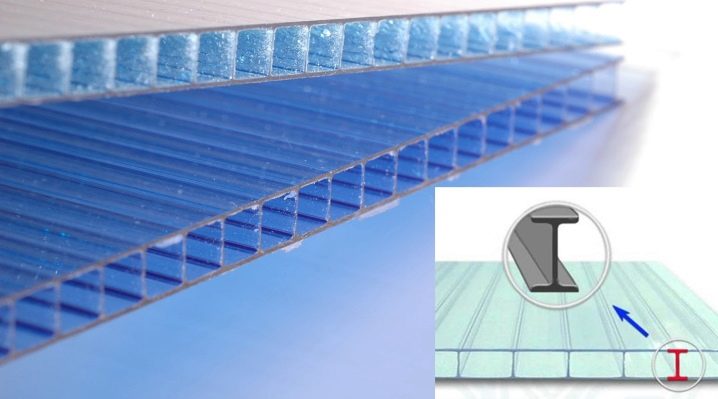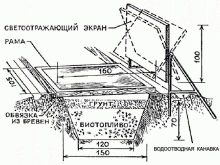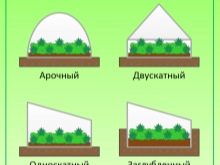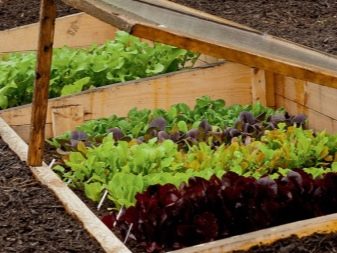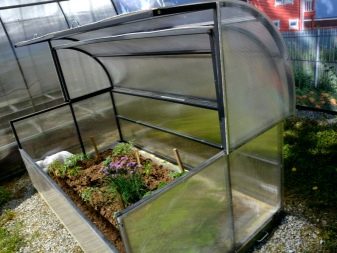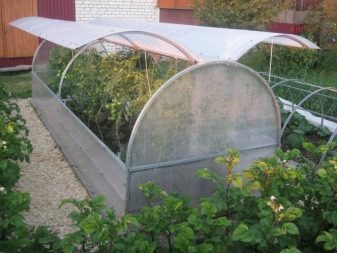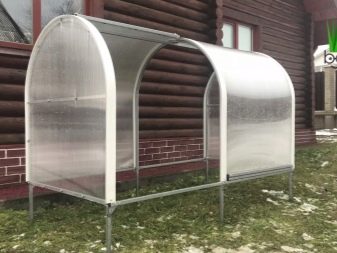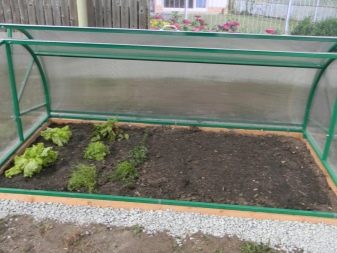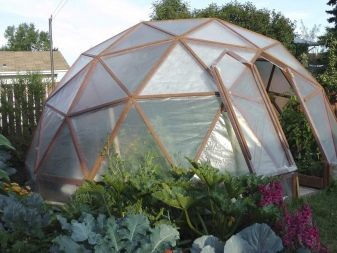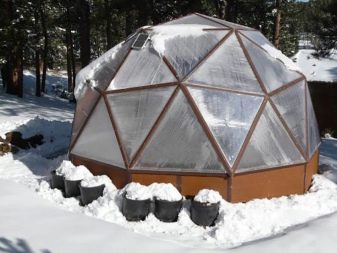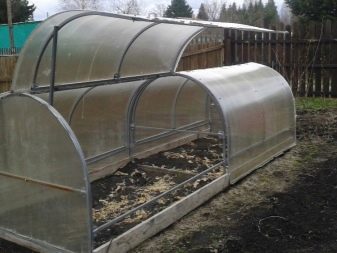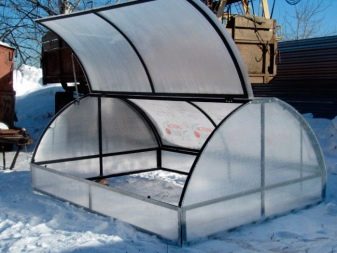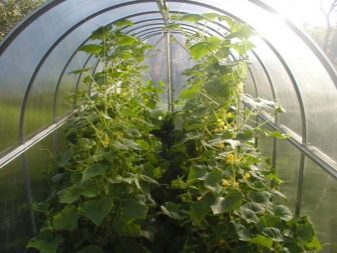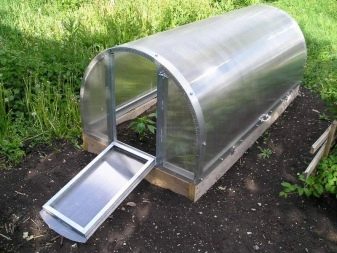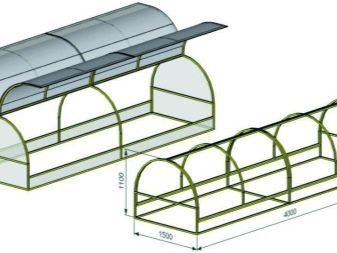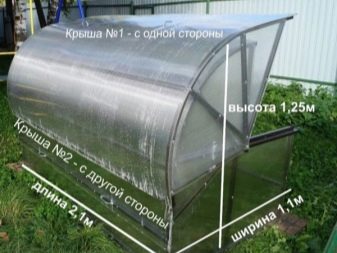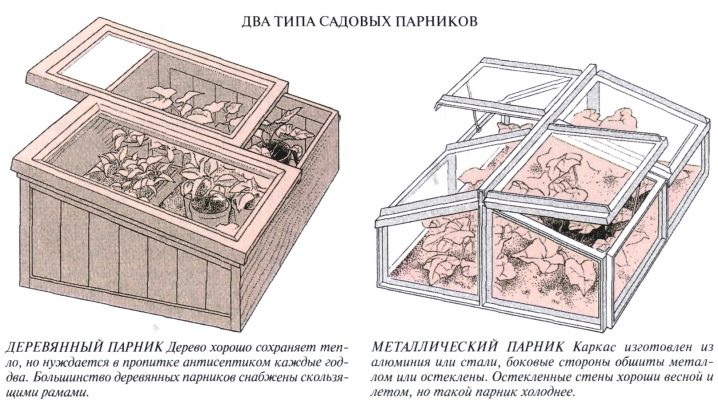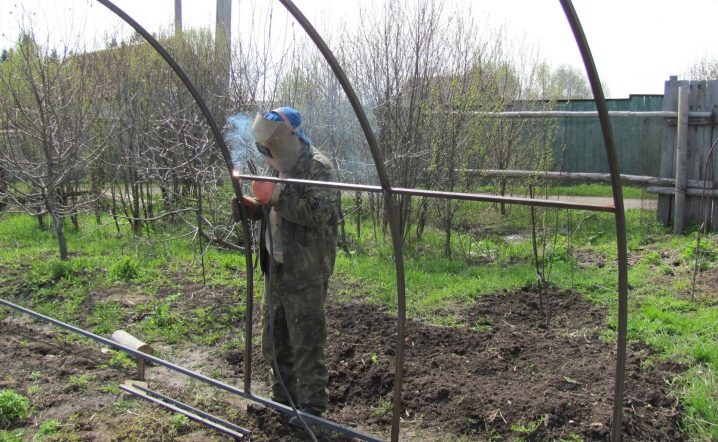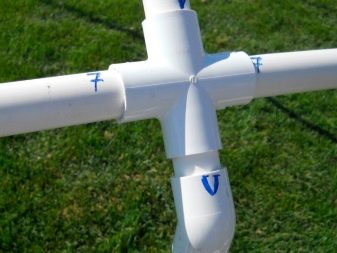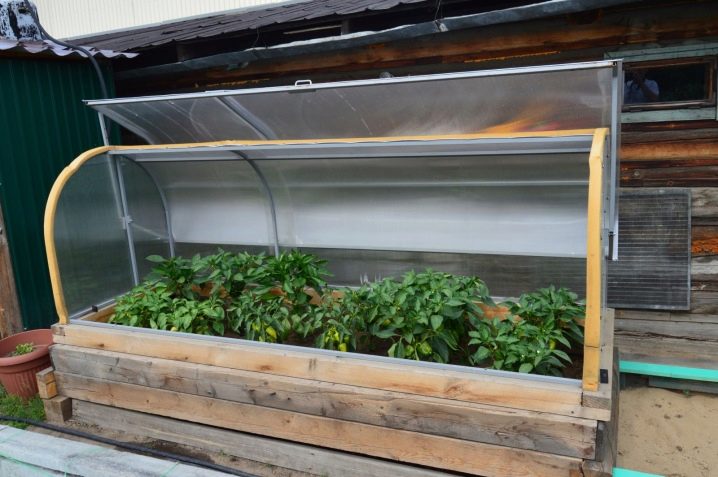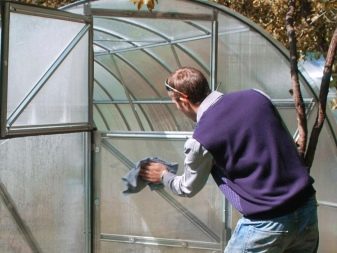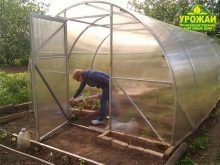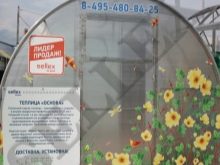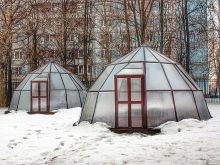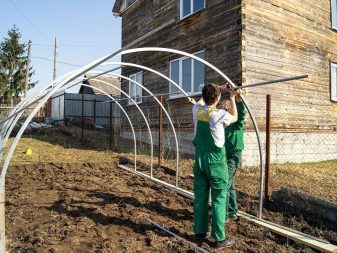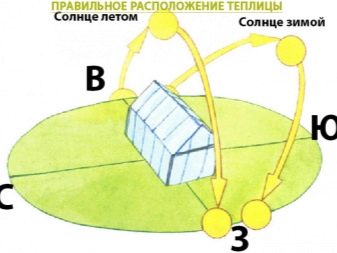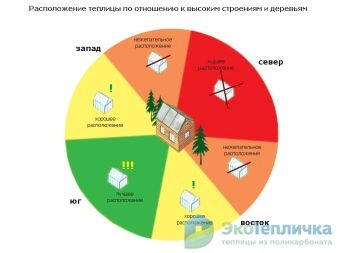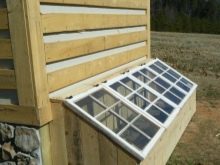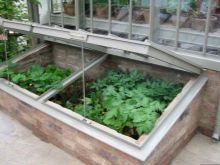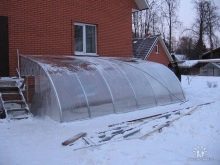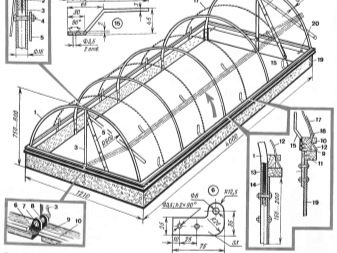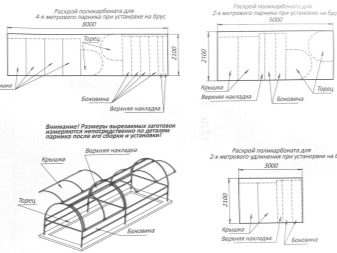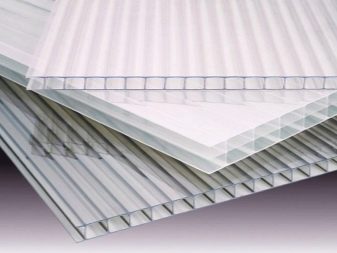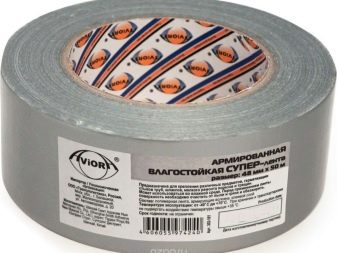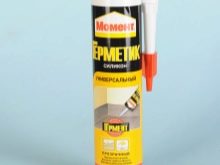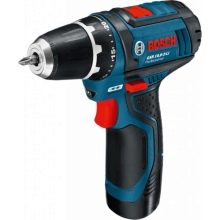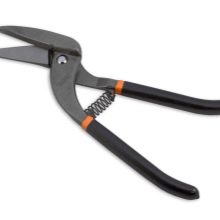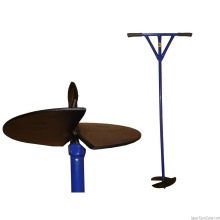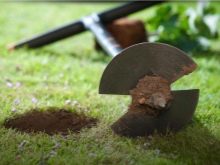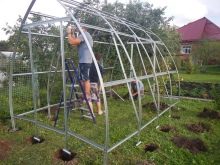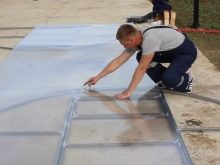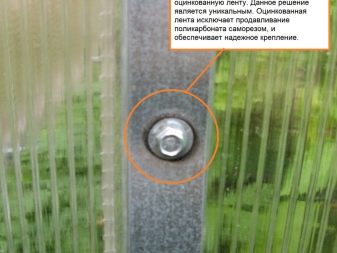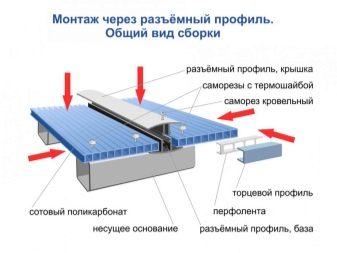Polycarbonate Greenhouse: Dimensions and Types of Forms
A greenhouse is an integral part of almost any Russian vegetable garden whose owners are aimed at obtaining a good crop. His presence on the plot gives an opportunity to start the summer season earlier and stretch it for the maximum possible time.
Models of greenhouses on the market today a huge amount. There is something to choose from. In addition, many people prefer to build this structure on their own, taking into account the individual sizes and features of their land plot.
Features: advantages and disadvantages
When it comes to building a greenhouse, many people often confuse it with a greenhouse, thinking that there is no difference between them.
If in a greenhouse, to ensure a suitable microclimate for plants, solarlight, and also in certain cases coal, gas, electric or even wood heating can be used, the greenhouse is self-sufficient in the energy sense.
It is “heated” by manure or compost, in which the biological process of decay takes place. On the principle of the greenhouse says its own name, because the design allows you to create a greenhouse effect.
In contrast to the greenhouse, in the greenhouse there are no doors that can be entered. This is usually a small structure that allows to ventilate the internal space at the expense of a raised lid or recessed walls.
From the choice of material for construction depends on the effectiveness of the "work" of the greenhouse. In the old days, glass was often used to create it. (Although such designs in our time still occur in gardens). Sometimes ordinary window glasses were allowed to work, which they had to be replaced from time to time, as they often broke.
The same story happened with polyethylene. Despite the fact that under it cucumbers and seedlings feel great, this material may not be enough even for one season.The only annoying trouble is enough when such a shelter is torn by a storm wind or a sharp object.
Better than glass and polyethylene polycarbonate, which is already becoming familiar in the manufacture of greenhouses and greenhouses. It is two hundred times stronger than glass, and comparing it with this indicator with polyethylene does not make sense at all. This product of modern life will cost more than traditional materials that are gradually emerging from use in the garden, but it can serve for a long time. This greenhouse will be convenient to use.
Polycarbonate is a type of plastic. On sale you can find monolithic and cellular polycarbonate. Monolithic is actively used in construction, but for the construction of "houses for plants" it is better not to take it, because it is not intended for active heat retention. It is better to adopt a cellular.
In it between the two thin polymer sheets at regular intervals set the so-called stiffening ribs connecting the two halves of the coating between them. The cavities between the connecting elements are filled with air. Due to this structure, cellular polycarbonate well passes light and weighs little, and it supports heat much better than its monolithic fellow.
Types and forms
Depending on their device greenhouses are in-depth and above-ground.
Recessed looks like a trench with a top strapping of planks, bricks or other material.available on the farm. Due to such a device, a “special bed” requires less “preheating agent”. In-depth greenhouses are made with both single-slope and gable roof, as well as arched. At the same time, those who have flat sheds are called Russians, and the gabled houses are called Belgian ones. And they are suitable for tall plants.
Above-ground greenhouse is otherwise called portable. He also has the name of Paris or French. In such a construction "pillow" of manure is located under a layer of soil. As the “coolant” declines, the greenhouse has to be renewed.
Finished polycarbonate products for growing various garden crops are usually an aboveground option. Although you can choose one that can be used as a roof for an in-depth version of the "insulated beds." And if there is nothing suitable for sale, it is not difficult to independently build a greenhouse with a covering from a honeycomb polycarbonate sheet.
The frame greenhouse is often made on a metal base, this “skeleton” is galvanized, sometimes reinforced.
Modern buildings for vegetables differ in a variety of different configurations and intricate names. Many at the same time receive a proud prefix "eco". This may be an ordinary rectangular greenhouse with a roof. There are polycarbonate with a shell-type opening top, with hinged lids.
An interesting option is the greenhouse butterfly. Its walls rise up, so you can freely approach the plants from either side. In hot weather, this design is easily ventilated.
The tulip greenhouse has a sliding principle of adjustment, as well as a greenhouse-breadbasket, which is very convenient for giving with a limited garden area, where every square meter of land is gold. The advantages of such structures are obvious compared to, for example, the “Perchin” greenhouse and the greenhouse covered with film.
Original looks round greenhouse. It may be, for example, an arched structure. Such structures are used both for sprouting seedlings and for full-fledged cultivation of various crops, including the stage of fruit harvesting.Under the dome, it keeps warm remarkably, and the structures of such a shape are notable for durability, maintaining a good layer of snow in winter.
In addition, round-shaped greenhouses can decorate the summer and garden plots.
There are altogether advanced models of constructions with automatic ventilation, which can save a summer resident from unnecessary winding from the city to his site and back in order to close or open a greenhouse with his favorite cucumbers.
The self-made polycarbonate greenhouses, created by skillful hands, in many respects repeat the forms and principles of the shop counterparts and apparently do not sometimes differ from them.
Dimensions
The size of the greenhouse is an individual matter. Someone, with the help of a mini-type construction, is able to provide themselves with fresh vegetables for the whole summer, growing them on a square meter, and for some people even a 3 by 6 site will not seem enough. Someone used to a greenhouse at 4 x 8 meters and for years has received a steady harvest from it.
A small greenhouse will find its place in the garden with a limited area. Narrow, sometimes very low constructions are also appropriate here.
The size of the building may also depend on how the plants are located under its roof.It is necessary to understand how the width of the tracks is convenient for processing in a particular case, how many of them are needed. This will help you navigate what area and configuration of the greenhouse will suit a particular user.
When determining the area of polycarbonate construction, one should also keep in mind that the standard sheet of material is 2.1 by 6 meters. It is not by chance that greenhouses 2 m wide can be met quite often. Given that the material is cut, it is easy to build structures of different sizes - from small to very impressive. It can be about 6x3, and 2x3, and 2x4, and 3x4, and 2x6 m.
The height of the greenhouse is usually about one and a half meters or less.
Frame materials
To create the frame of the future greenhouse, you can use different materials. This can be, for example, wood, metal profile, plastic or metal-plastic.
The tree is most accessible to create the basis of a structure Such a frame is easy to assemble. It is durable and stable. It can serve for a long time if you choose a material of decent quality for construction and process it correctly. In order for the construction on such a basis to be truly durable, you need to use only dried wood without signs of rotting, and after creating the “skeleton”, do not neglect the application of moisture resistant paint on it.
Polycarbonate to the wooden frame is very convenient to mount. And especially reliable foundation for such a greenhouse is not required. It is enough to make the supporting pillars.
Metal frames are characterized by durability and decent service life. Often they are made from a shaped pipe or thick reinforcement. Since such a foundation for construction is heavier than wood, in some cases a strip foundation is made for it. Even when it is poured into it, the pipes for the frame are installed.
In the use of metal for a greenhouse has its difficulties. The metal structures themselves can not be called cheap, but to mount the frame, you need a welding machine plus the ability to use it.
A good option for a greenhouse device is the use of metal pipes. They do not need to be specially treated to protect against the influence of natural processes leading to destruction, as is the case with metal and wood. And it justifies the cost of purchasing the pipes themselves.
This material is as strong as metal, and the installation of the frame from it is no more difficult than from wood. Metal pipes bend well.This allows you to make them comfortable arched structures.
Just make a frame for a greenhouse of polypropylene pipes. Using various key elements, it is easy to create designs of various shapes and sizes.
How to choose?
The choice of greenhouse due to the specific tasks that the owner of the land sets. For seedlings, which will then be transplanted to a garden bed, you can make a small “house” of the simplest form, for example, resembling a chest with a hinged lid. Although if the seedlings are grown for sale, you will need a large area.
In almost every area where gardening is seriously involved, you can see a greenhouse for cucumbers and peppers. The most convenient cucumber greenhouse is considered to be a butterfly and bread box design. It is convenient to ventilate, besides, it is not necessary to reach for vegetables when they are harvested.
How to wash?
Polycarbonate coating needs to be periodically processed, since during the summer season green traces of plants, soil and other dirt accumulate on it. The coating ceases to transmit enough light, which degrades the quality of growth and well-being of the next "green tenants" under its roof.On polycarbonate, microorganisms sometimes accumulate that can destroy the future crop.
In order not to damage this material, do not use abrasive cleaners.with which, for example, they wash the dishes, and with hard brushes, and even more so with metal meshes. For washing in this case, a soft cloth or sponge is useful, as well as ordinary water with soda. You can also use a soap solution. All detergents used in the treatment must be properly removed with clean water. To be sure, you can stream the design from a hose.
Manufacturers
There are a lot of people in love with the land and agriculture in Russia. The demand for products for the garden is always high. Therefore, it is not surprising that there are enough manufacturing firms supplying the relevant goods to the market.
According to customers, among the leading industrial organizations that create prefabricated greenhouses and greenhouses, we can note the following:
- "Harvest";
- "The foundation";
- Glass house;
- "Novoladozhsky plant";
- "Will".
They offer a wide range of designs, adapted to the difficult Russian climate, and able to satisfy the needs of even the most demanding customer.
How to do it yourself?
To prepare for the spring garden, not depriving him of such an important component as a greenhouse, you can not only purchase a store product, but also build a small building that can meet all the requirements of the owners.
Experienced summer residents are advised to plan construction either for March or for the end of November. This is equally practical, since the season of activity on the land is still far. At this time there is no risk of damaging any plants in the garden beds. And the temperature for working with polycarbonate is the most suitable - about +10 degrees.
If the installation is carried out at too high a temperature, then when it gets colder, polycarbonate will “shrink” in size and the joints between the sheets will turn into slots, from which valuable heat will then evaporate. If, however, to carry out construction in cold weather, then with the arrival of summer, it will be found that the structure has twisted as the polycarbonate has expanded. In the end, all your labors go to ashes.
When thinking about construction, you need to keep in mind a number of factors:
It is important to correctly put the structure on the site. It is better to orient the building from west to east.So the plants will be able to get more sunlight.
If the greenhouse should be no higher than one and a half meters, the construction using arched arcs will be the wrong decision. A strongly curved polycarbonate coating reflects light back, so the temperature inside the building will not be much higher than the outside. Easier and more rational in this case to make a "house for plants" with flat walls and a roof.
You can make it stronger not only due to the special reinforcement of the structure, but also if you “lean” the structure to the southern part of another building - a shed or, for example, a residential building. Such a neighborhood will protect the greenhouse from strong winds.
Starting to work with polycarbonate, it should be borne in mind that it bends easily in one direction and badly in another. This is due to the properties of the cell structure. When installing a greenhouse, this must be taken into account in order not to ruin some of the material available.
The construction itself must start from the stage of drawing up the drawings.
For the manufacture of a greenhouse on a metal frame will need:
- polycarbonate 4-6 mm thick;
- adhesive tape for waterproofing seams;
- metal mounting profiles;
- silicone sealant.
You also need to stock up on a tool:
- screwdriver;
- scissors for metal;
- self-tapping screws;
- garden drill.
Work begins with the installation of the foundation, because the greenhouse will have a mass of several tens of kilograms. The easiest way to make a foundation for the construction of four pipes, dug in the corners of the structure. The pipes should be painted for waterproofing, and then driven into the drilled wells to a depth of about one meter so that future supports protrude twenty centimeters above the ground.
To assemble the frame of the construction, the metal profile is cut according to the scheme. Its elements are connected with screws and attached to the foundation. Further, in accordance with the dimensions previously indicated in the drawing, the pieces of polycarbonate are cut.
Assembly on the frame do one of the ways. With the help of a strip of metal: the junction of sheets of polycarbonate is covered with a piece of aluminum tape. Attach it to the "skeleton" with self-tapping screws so that they fall into the base through the gap between the sheets of the greenhouse cover.
The second method of fasteners - using the N-shaped profilewhich is exactly intended for such cases: it is fixed on the frame, after which it is easy to install polycarbonate sheets into it.Having completed the installation of the walls, the joints between the polycarbonate sheets are treated with silicone sealant.
At the ground, the structure is sheathed with a metal strip or with boards treated with an antiseptic. The same is done with the edges of the greenhouse.
The lid of the building can be constructed from a piece of polycarbonate attached with screws to the structure's body.
With at least some construction experience, it is not difficult to create a greenhouse of unpretentious construction.
To learn how to make a greenhouse with your own hands, see the following video.

